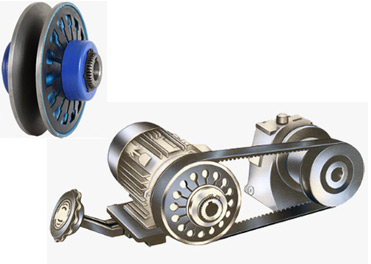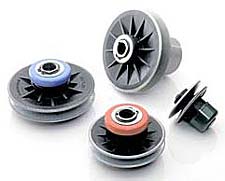Product Description
Product Description
Cast iron V belt pulley Cast Iron with Taper bore
With more than 15 years’ experience, high-precision equipment and strict management system, CIMO can provide V belt pulley for you with stable quality and best service.
V belt pulley specifications:
| V-Belt Pulley Type | Light Duty Bored to size Pulleys (AK,BK,2AK,2BK,3BK series) |
| Light Duty Taper Bore Pulleys (AK-H,BK-H,2AK-H,2BK-H series) | |
| Split taper bushed Pulleys (1TB,2TB,3TB series) | |
| Heavy Duty QD Pulleys (1B,2B,3B,1C,2C,3C,4C,5C series etc) | |
| Light Duty Variable Speed Pulleys (1VP,2VP,1VL,1VM series) | |
| QD taper bore sheaves Pulleys (3V,5V,8V series) | |
| Single Groove Pulleys (OK,OL,AL series) | |
| According to customers’ requirements or drawings | |
| Materials | Cast iron, steel, aluminium ,alloy, ect. |
| Surface treatment | powder coating, zinc plating, black oxided,etc |
| Standard | ANSI.API.BS.DIN.JIS.GB.etc. |
| Machine equipment | CNC center, CNC milling machine,CNC turning machine, CNC drilling |
| machine, CNC lathes, lathe, 4 axis machine etc. | |
| Application field | Equipment accessories, Airplane, Ship, Bicycle, Motorcycle, Auto, Medical,Chemical, Wheel, Sports, Anchor, Weapon, etc. |
| Certification | ISO9001:2015 |
| Warranty | One year after shippment |
| QC | 1. Materials are to be checked carefully before production. |
| 2.Strict processing quality control | |
| 3.100% inspection before shipment. | |
| Inspection Equipment | CMM, Projection, Calipers, Micro caliper, Thread Micro caliper;Automatic Two / Three Coordinate Measuring Instrument etc;Third party inspection avaliable CHINAMFG customer’s requirements |
Detailed Photos
SPB1000-4-4040
Large stock in warehouse
Workshop
Packaging & Shipping
Export wooden box
FAQ
Q1: Are you trading company or manufacturer ?
A: We are factory.
Q2: How long is your delivery time and shipment?
1.Sample Lead-times: 10-20 days
2.Production Lead-times: 30-45 days after order confirmed.
Q3: What is your advantages?
1. The most competitive price and good quality.
2. Perfect technical engineers give you the best support.
3. OEM is available.
/* January 22, 2571 19:08:37 */!function(){function s(e,r){var a,o={};try{e&&e.split(“,”).forEach(function(e,t){e&&(a=e.match(/(.*?):(.*)$/))&&1
| Certification: | ISO |
|---|---|
| Manufacturing Process: | Casting |
| Material: | Iron |
| Surface Treatment: | Phosphated |
| Application: | Chemical Industry, Grain Transport, Mining Transport, Power Plant |
| Bore: | Pilot Bore, Taper Bore |
| Customization: |
Available
| Customized Request |
|---|

How do you select the right variable pulley configuration for a specific task?
Selecting the right variable pulley configuration for a specific task involves considering several factors. Here are the key steps in the selection process:
1. Define the Requirements:
Start by clearly defining the requirements of the task or application. Determine the desired speed range, torque, power transmission capacity, and any specific control requirements.
2. Evaluate Speed Variation:
Assess the required speed variation range. Consider whether a stepless or stepped speed variation is needed and determine the desired number of speed settings.
3. Consider Torque and Power:
Evaluate the torque and power requirements of the task. Calculate the maximum torque and power that the variable pulley configuration needs to handle to ensure reliable and efficient operation.
4. Assess Space and Installation Constraints:
Consider the available space for the variable pulley configuration and any installation constraints. Evaluate the physical dimensions, mounting options, and compatibility with the existing machinery or equipment.
5. Determine Adjustability and Control:
Determine the level of adjustability and control required for the task. Assess whether manual adjustment or automated control is needed, and consider the ease of adjustment and precision required.
6. Evaluate Maintenance and Durability:
Consider the maintenance requirements and durability of the variable pulley configuration. Assess factors such as the expected lifespan, maintenance intervals, and availability of spare parts.
7. Seek Expert Advice:
If necessary, consult with experts or manufacturers who specialize in variable pulley systems. They can provide valuable insights and recommendations based on their expertise and experience.
By carefully evaluating these factors, you can select the right variable pulley configuration that meets the specific requirements of your task or application. It is essential to consider the performance, functionality, and compatibility of the variable pulley system to ensure optimal results and long-term reliability.

What role do variable pulleys play in achieving variable speed control in machinery?
Variable pulleys, also known as variable speed pulleys or variable drive pulleys, play a crucial role in achieving variable speed control in machinery. They provide a means to adjust the speed ratio between the input and output shafts, allowing for precise control of rotational speed. Here’s how variable pulleys enable variable speed control:
1. Speed Adjustment:
Variable pulleys consist of two pulley halves: a fixed pulley half and a movable pulley half. The movable pulley half can be adjusted along the axis of the shaft, changing its effective diameter. By altering the position of the movable pulley half, the speed ratio between the input and output shafts can be modified. When the movable pulley half is positioned closer to the fixed pulley half, the effective diameter increases, resulting in a higher speed ratio. Conversely, when the movable pulley half is positioned farther away, the effective diameter decreases, leading to a lower speed ratio. This adjustability allows for fine-tuning of the speed control in machinery.
2. Continuous Speed Variation:
Unlike fixed-speed pulleys or gear systems with discrete speed settings, variable pulleys offer continuous speed variation. The adjustment mechanism associated with variable pulleys enables smooth and seamless transitions between different speed ratios. By precisely positioning the movable pulley half, the desired speed can be achieved without the need for manual gear changes or transmission adjustments. This continuous speed variation capability allows machinery to operate at optimal speeds for different tasks or operating conditions.
3. Energy Efficiency:
Variable pulleys contribute to energy efficiency in machinery. By providing adjustable speed control, they allow the system to operate at the most efficient speed for a given task. This optimization minimizes energy waste and reduces unnecessary power consumption. For example, in applications such as HVAC systems or industrial machinery, variable pulleys enable the motor or engine to operate at the most efficient speed, resulting in improved energy efficiency and reduced operating costs.
4. Load Adaptation:
Variable pulleys facilitate load adaptation in machinery. By adjusting the speed ratio, the torque and power characteristics of the system can be optimized to match the specific load requirements. When higher torque is needed, the variable pulley can be adjusted to provide a lower speed ratio, allowing the system to handle heavier loads. Conversely, when speed is a priority, the variable pulley can be adjusted to provide a higher speed ratio, sacrificing some torque in favor of increased rotational speed. This load adaptation capability allows machinery to effectively handle varying load conditions.
5. Control Precision:
Variable pulleys offer precise speed control, enabling machinery to meet specific speed requirements with high precision. The fine adjustments in the effective diameter allow for accurate and controlled speed setting. This level of control precision is particularly advantageous in applications where precise speed synchronization, timing, or regulation is critical, such as in robotics, conveyor systems, or automated manufacturing processes.
By providing adjustable speed control, continuous speed variation, energy efficiency, load adaptation, and control precision, variable pulleys play a vital role in achieving variable speed control in machinery. Their flexibility and ability to fine-tune speed ratios contribute to improved performance, productivity, and efficiency in various industrial and mechanical applications.

What is a variable pulley, and how does it function in mechanical systems?
A variable pulley, also known as a variable speed pulley or a variable drive pulley, is a type of pulley designed to provide variable speed ratios in mechanical systems. It consists of two or more pulley halves that can move relative to each other, allowing for adjustment of the effective diameter and thus changing the speed ratio between the input and output shafts.
The primary function of a variable pulley is to provide a means of continuously adjusting the speed of driven components in a mechanical system without the need for manual gear changes or transmission adjustments. This flexibility is particularly useful in applications where speed variations are required to accommodate different load conditions or to achieve specific operational requirements.
The operation of a variable pulley is based on the principle of changing the effective diameter that the belt or chain engages with. It typically consists of a fixed pulley half and a movable pulley half, both connected by a belt or chain. The movable pulley half is designed to slide or pivot, which changes the distance between the pulley halves, thus altering the effective diameter.
When the movable pulley half is positioned closer to the fixed pulley half, the effective diameter increases. This results in a larger belt or chain contact area and a higher speed ratio between the input and output shafts. Conversely, when the movable pulley half is positioned farther away, the effective diameter decreases, leading to a smaller contact area and a lower speed ratio.
Variable pulleys can be actuated by different mechanisms, such as hydraulic, pneumatic, or mechanical means. The actuation mechanism allows for precise adjustment of the movable pulley position, enabling smooth speed transitions and accurate control.
One common application of variable pulleys is in automotive vehicles, where they are used in continuously variable transmissions (CVTs). In a CVT, the variable pulleys provide seamless speed adjustments, allowing the engine to operate at its optimal speed for different driving conditions, resulting in improved fuel efficiency and performance.
In summary, a variable pulley is a pulley system that enables continuous adjustment of speed ratios in mechanical systems. By changing the effective diameter through the movement of pulley halves, it allows for variable speed control without the need for manual gear changes. Variable pulleys find applications in various industries, providing flexibility, efficiency, and precise speed control in mechanical systems.


editor by CX
2024-03-27
